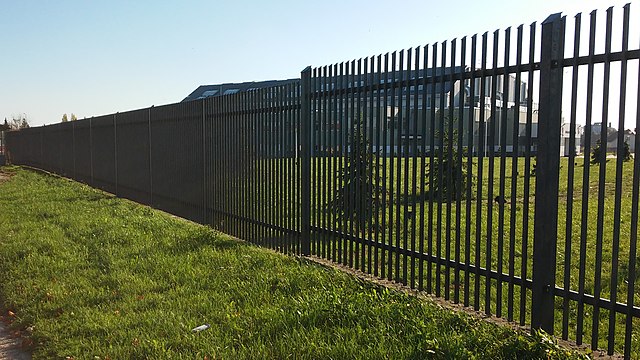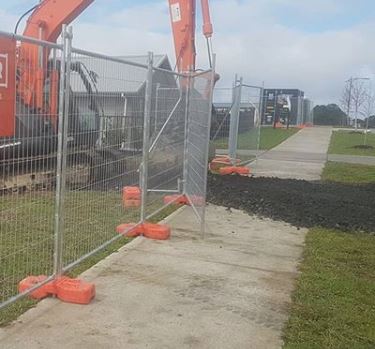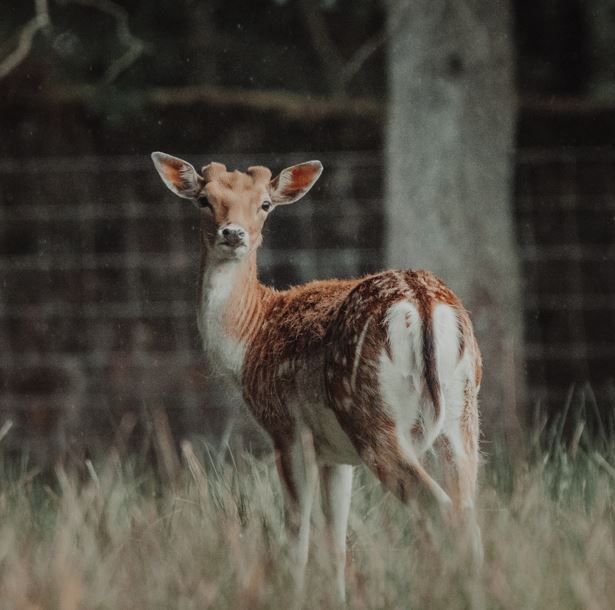
We appreciate the beauty and grace of deer, but we also understand the significant damage they can cause to our New Jersey properties. To safeguard our investments from these browsing animals, installing a quality deer fence is crucial.
A deer fence provides an effective solution to keep deer at bay while being practically invisible from a distance, ensuring our landscape views remain unobstructed. Additionally, deer fencing offers seasonal protection, allowing for flexibility in installation and removal based on the changing seasons.
Understanding Deer Behavior and Habitat
Understanding deer behavior and habitat is crucial in designing and installing an effective deer fence. Deer are naturally attracted to areas with abundant food, water, and shelter. They tend to follow established trails and can jump high and long distances, making it essential to design a fence that takes these behaviors into account.
Deer are most active during dawn and dusk, often moving in specific patterns. They have a keen sense of smell, allowing them to detect food sources from a considerable distance. By recognizing these behaviors, you can strategically place your fence to intercept their usual routes and deter them from entering your property. This knowledge will help you create a more tailored and effective deer exclusion strategy, ensuring your landscape remains protected.
Assessing Your Property’s Deer Attractants
Assessing your property’s deer attractants is a critical step in designing an effective deer fence. Deer are drawn to areas that offer plentiful food, water, and shelter. Identifying these attractants on your property will help you design a fence that effectively keeps deer out.
Common deer attractants include:
- Food sources: Gardens, crops, and landscaping plants are prime targets for hungry deer.
- Water sources: Ponds, lakes, and streams can attract deer looking for hydration.
- Shelter: Woods, thickets, and brush piles provide cover and protection for deer.
- Trails: Established paths and routes that deer use to move through the area.
By pinpointing these attractants, you can design a fence that addresses these specific areas, making it more difficult for deer to access your property. This targeted approach will enhance the effectiveness of your deer fencing efforts.
What Causes Deer Browsing Damage?
The main reason deer cause damage is because there are so many of them around New Jersey. Deer like to hang out where there’s a lot of food and places to hide.
When there are too many deer, they start looking for food everywhere, including in your garden. This means they can eat up a lot of trees, bushes, flowers, and other plants.
Besides having too many deer, sometimes people don’t manage their land well, which can also lead to problems. For example, if someone puts out food for deer to attract them, it can make the deer start exploring nearby yards for more plants to eat.
Some people also plant things that deer love to eat. Maybe they like the way certain plants look, or they remind them of home. But if a lot of people plant the same tasty plants, it gives deer a big buffet, and those plants might not survive if the deer keep eating them. That’s why managing what we plant and protecting our gardens with deer fences is so important.
What Can Be Done About Deer Browsing Damage?
What Is Deer Fencing?
Deer fencing is a special kind of fence that stops hoofed animals, like deer and elk, from getting into your garden or yard. It’s usually made from strong plastic or metal mesh with tiny openings, about 1 to 2 inches wide, so the deer can’t poke their heads through and get inside.
The fence is also tall enough to stop deer from jumping over it. Most of these fences are at least 8 feet tall. Did you know that deer can jump as high as 8 feet? According to the University of Vermont, white-tailed deer are capable of jumping over obstacles of this height, so having a tall fence is crucial to keep them out.
Benefits of Deer Fencing
The main benefit of using deer fencing is that it will protect your plants, trees, and other vegetation from being eaten by these animals. This can be especially helpful if you have an orchard or garden that you don’t want destroyed by hungry deer. In addition, it can help keep the deer away from areas where they might pose a risk to humans or livestock, such as near roads or farm buildings.
Another benefit of installing deer fencing is that it can help reduce the spread of disease between wild and domestic animals. By keeping wild animals away from livestock, farmers and ranchers are able to reduce their risk of diseases like bovine tuberculosis being spread between species. Finally, some areas may require homeowners and businesses to install fences in order to comply with local regulations concerning wildlife management practices. If this applies in your area, then installing a properly-constructed fence can help you stay compliant with those rules while still protecting your property from unwanted visitors.
Alternate Materials To Use For Your Deer Fence
Contrary to popular belief there are lots of different fencing materials you can use for your deer fence. These are some of the most safe and popular options for keeping deer out.
Wooden Fences
Wooden fences are one of the most popular choices for deer fencing. They are relatively inexpensive, easy to install, and provide a natural aesthetic for any yard or garden. Wooden fences are also very durable and can last for several years with minimal maintenance. The main downside to wooden fences is that they are susceptible to rot, mold, and damage from insects and weather if not treated properly.
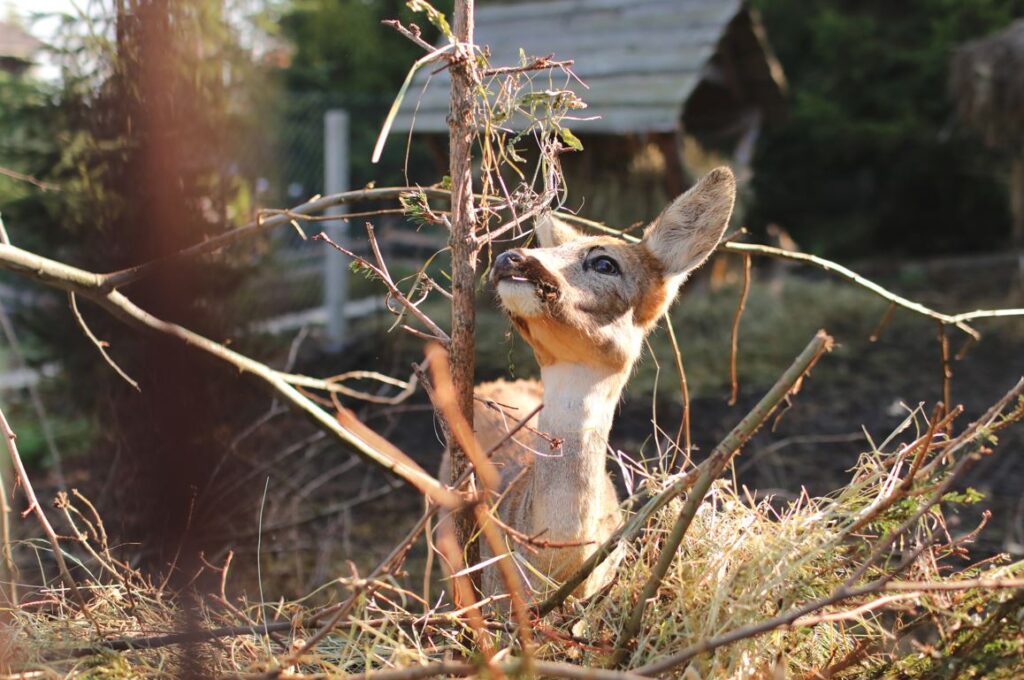
Metal Fences
Metal welded wire fences are another popular option when it comes to deer fencing. A metal fence is strong and durable, making them ideal for keeping out larger animals such as deer. They also require minimal maintenance, although they may need to be repainted every few years in order to maintain their appearance. The downside to metal fences is that they can be more expensive than wood or vinyl options.
Vinyl Fencing
Vinyl fencing is a great choice if you want a low-maintenance option that still looks good and provides plenty of protection against deer intrusion. Vinyl fences come in a variety of styles and colors, making it easy to find something that fits with your landscaping design. The downside to vinyl fencing is that it may not be as strong or durable as metal or wooden fences, so it may not stand up as well against severe weather conditions or strong winds.
Deer Fence Installation
Deer fence installation requires careful planning and execution to ensure that the fence is both effective and long-lasting. Here are some essential tips to consider when installing a deer fence:
- Choose the right materials: High tensile woven wire, electric fence, and polypropylene deer fencing are popular options known for their durability and effectiveness.
- Determine the right height: The fence should be at least 8 feet tall to prevent deer from jumping over it.
- Use corner posts and top wire: These components help maintain the fence’s structure and prevent deer from pushing through.
- Bury the fence: Burying the fence 12-18 inches underground can help prevent deer from burrowing underneath.
- Use fence line: A well-defined fence line helps establish the boundary of the fenced area and deters deer from entering.
By following these tips, you can ensure that your deer fence is robust and effective, providing long-term protection for your property.
Additional Deer Deterrents and Repellents
In addition to a deer fence, there are several other deterrents and repellents you can use to keep deer out of your property. These methods can complement your fencing efforts and create a multi-layered defense system:
- Motion-activated sprinklers: These devices can startle deer and keep them away from your property.
- Ultrasonic deer repellents: These emit a high-frequency sound that is unpleasant to deer, deterring them from entering the area.
- Deer repellent granules: These can be applied to plants and soil to create an unappealing environment for deer.
- Electric fencing: This can be used in conjunction with a deer fence to provide an additional layer of protection.
By incorporating these additional deterrents and repellents, you can enhance the effectiveness of your deer exclusion efforts and better protect your property.
Deer Fence Maintenance and Repair Considerations
Debris Clearance
Deer fences can quickly become clogged with debris over time, so it’s important to regularly clear any debris that might accumulate on the surface of the fence. Leaves, branches and other natural debris can all interfere with the effectiveness of your deer fence if left unchecked. To prevent this from happening, use a soft-bristled brush or hand-held vacuum to remove any loose material that accumulates on the surface of the fence. You can also periodically use a pressure washer on low setting to help remove stubborn dirt or grime that may have built up over time.
Repairs and Replacement Parts
Just like any other piece of outdoor equipment, your deer fence will need repairs over time. It’s important to check for signs of damage such as holes or tears in the material at least once every two months. If you spot any damage in the fabric of your deer fence, you should consider replacing the damaged section as soon as possible in order to ensure that it remains effective against unwanted visitors such as deer or other animals. Additionally, make sure to replace any broken or missing parts such as posts or clips when needed in order to keep things functioning properly.
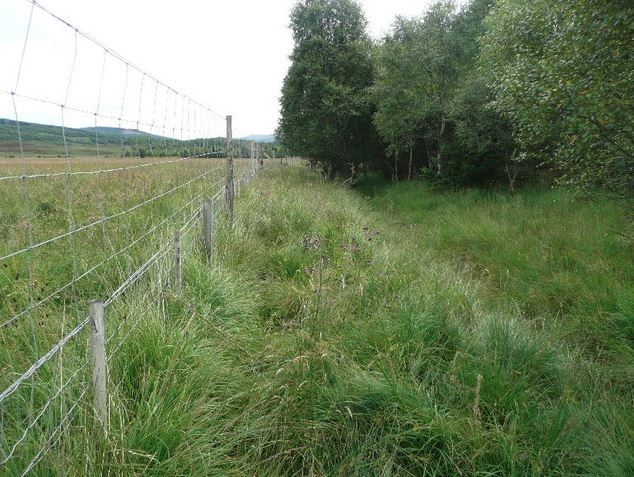
Regular Inspections
It is also important to inspect your deer fence at least once every six months for signs of wear and tear or damage caused by external factors such as extreme weather conditions. During these inspections, look for any weak points where the material has been stretched too far or worn away due to excessive use or exposure to harsh elements such as rain or snow. Make sure to repair any issues identified during these inspections in order to maintain optimal performance from your deer fencing system over time.
DIY vs. Professional Installation
When it comes to deer fence installation, you have two options: DIY or professional installation. Here are some pros and cons of each option to consider:
DIY Deer Fence installation:
- Pros: Cost-effective, allows you to install on your own schedule.
- Cons: Requires technical expertise, can be time-consuming and labor-intensive.
- Professional installation:
Professional Deer Fence installation:
- Pros: Ensures a high-quality installation, can be customized to your specific needs.
- Cons: More expensive, requires scheduling and coordination with a contractor.
Ultimately, the decision to DIY or hire a professional will depend on your specific needs and circumstances. If you have the technical expertise and time to devote to the project, DIY installation may be a good option. However, if you want to ensure a high-quality installation and don’t have the time or expertise, hiring a professional may be the better choice.
By carefully considering these factors, you can make an informed decision that best suits your needs and ensures the effectiveness of your deer fence.
Using Deer Fence To Protect Your New Jersey Property
Deer fence is an effective way to protect your NJ property from damage caused by deer browsing. With a variety of materials available for use in constructing the fence and regular maintenance and repair considerations, you can ensure that it remains strong and secure over time.
Most orders for deer fencing materials will ship within one business day, ensuring quick and efficient delivery.
Don’t forget to inspect your fence regularly for signs of wear or damage so that you can make any necessary repairs right away. By taking these steps, you will be able to keep unwanted visitors at bay while also protecting your garden or yard from costly browsing damage!

